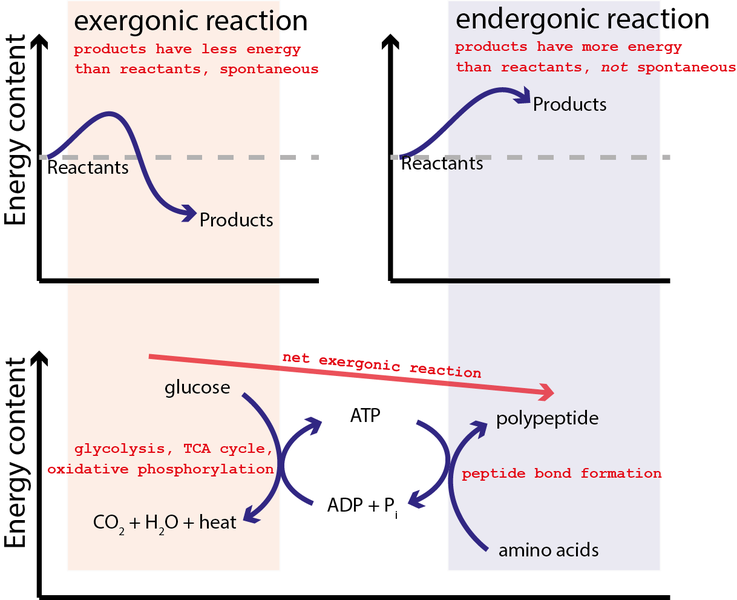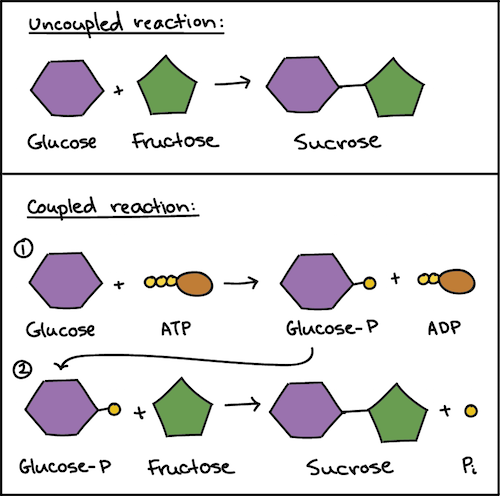Coupling Endergonic and Exergonic Reactions
ATP is responsible for mediating most energy coupling in. The breakdown of glucose producing ATP.
Figure 86 Coupling of Reactions Exergonic cellular reactions release the energy needed to make ATP from ADP.

. You have to pick the. Endergonic and exergonic reactions 32 related questions found. Free energy is captured and retained in the PO bonds of ATP.
An endergonic reaction occurs by coupling with an even more exergonic reaction. Oxidation-reduction redox reactions are examples of the coupling of. The overall reaction becomes exergonic and spontaneous.
Coupling of exergonic and endergonic reactions is very common in metabolism. The reaction ADP P -- ATP is a n _____ reaction. In exergonic reaction the free energy of the products is lower than that of.
An exergonic reaction is one in which the energy level of the products is lower than the energy level of the reactants a spontaneous reaction. A coupled reaction is one in which energy from an exergonic reaction is used to drive an endergonic reaction. The only way that an endergonic reaction can occur spontaneously is if it is coupled with an even more exergonic reaction.
The process is called energy coupling. The energy released from an exergonic reaction can be used to drive an energy-requiring endergonic reaction. One example of an exergonic reaction is cellular respiration in both plants and animals.
Why is an enzyme critical for coupling an exergonic and ednergonic reaction. In cells what is usually the immediate source of energy for an endergonic reaction. Endergonic exergonic exothermic and endothermic reactionsWatch the next lesson.
The energy for an endergonic reaction comes from a n _____ reaction. Energy coupling of endergonic and exergonic reactions within cells permits biological reactions to proceed at temperatures consistent with life uses heat released by one reaction to fuel the other reaction and utilizes ATP to carry energy between the exergonic and endergonic reactions. An exergonic reaction is one in which ΔG increases and an endergonic process is one in which ΔG decreases.
Exothermic reaction When energy is released in a chemical reaction it is called an exergonic reaction. How does ATP participate in energy-coupling reactionsa Hydrolysis of ATP fuels endergonic reactionsb Hydrolysis of ADP fuels endergonic reactionsc Synthesis of ATP fuels exergonic reactionsd Synthesis of ADP fuels exergonic reactions. Exergonic and endergonic reactions result in changes in Gibbs free energy.
In cells this process generally occurs in one of two ways either through the transfer of electrons or the transfer of a phosphate group. The energy released from the conversion of ATP back to ADP can be used to fuel endergonic reactions. What is the fate of the phosphate group that is removed when ATP is converted to ADP.
Solution for Coupling Endergonic Exergonic Reactions in Metabolism Hesss Law. Enzymes can couple exergonic reactions with endergonic reactions to result in a coupled reaction that is exergonic overall. Energetic coupling between exergonic and endergonic reactions allows free energy released from one reaction to drive another.
The only way that an endergonic reaction can occur spontaneously is if it is coupled with an even more exergonic reaction. The key to coupling exergonic and endergonic reactions is the formation of this phosphorylated intermediate which is more reactive less stable than the original unphosphorylated molecule. Energy coupling of endergonic and exergonic reactions within cells permits biological reactions to proceed at temperatures consistent with life uses heat released by one reaction to fuel the other reaction and utilizes ATP to carry energy.
In chemical thermodynamics an endergonic reaction also called a heat absorbing nonspontaneous reaction or an unfavorable reaction is a chemical reaction in which the standard change in free energy is positive and an additional driving force is needed to perform this reaction. The sum of the ΔG values of the two reactions is then negative. Use the appropriate AG values below from the table.

9 6 Coupled Reactions Chemistry Libretexts

Endergonic And Exergonic Reactions Feedback Inhibition Youtube


No comments for "Coupling Endergonic and Exergonic Reactions"
Post a Comment